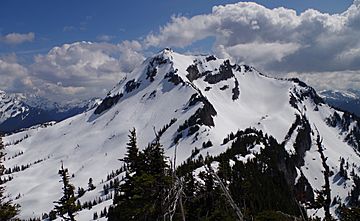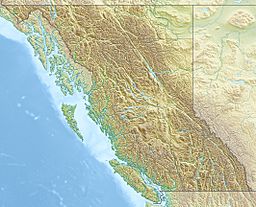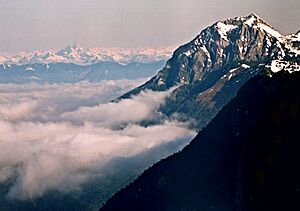Mount McGuire (Cascade Range) facts for kids
Quick facts for kids Mount McGuire |
|
|---|---|

Mt. McGuire, north aspect
|
|
| Highest point | |
| Elevation | 2,008 m (6,588 ft) |
| Prominence | 465 m (1,526 ft) |
| Parent peak | Canadian Border Peak |
| Geography | |
| Location | British Columbia, Canada |
| Parent range | Skagit Range North Cascades |
| Topo map | NTS 92H/4 |
| Geology | |
| Mountain type | Intrusive |
| Type of rock | Limestone |
| Volcanic arc/belt | Pemberton Volcanic Belt |
| Climbing | |
| First ascent | 1906 by James J. McArthur |
| Easiest route | Scrambling |
Mount McGuire is a mountain in southwestern British Columbia, Canada. It stands tall at 2,008-metre (6,588-foot) (about 6,588 feet) in the Cascade Mountains. The mountain is located about 4 km (2 mi) north of the Canada–United States border. It is also about 19 km (12 mi) southeast of Chilliwack and 7.4 km (5 mi) northwest of Canadian Border Peak.
Water from Mount McGuire flows into streams that lead to the Chilliwack River. The western side of the mountain drops very steeply, about 1,800 metres (5,900 feet), into Tamihi Creek.
The mountain was once called Tamihi. This name comes from the Halkomelem language of the local First Nations people. It refers to a historical practice of the community. The name McGuire was first shown on a map in 1917. It became the official name on October 6, 1936. The first people to climb Mount McGuire were James J. McArthur and his survey team in 1906. They reached the top by following the Southeast Ridge.
Contents
How Mount McGuire Formed
Mount McGuire is part of a larger rock formation called the Chilliwack batholith. This formed when hot, molten rock pushed its way into the Earth's crust. This happened about 26 to 29 million years ago. This area is also part of the Pemberton Volcanic Belt. This was once a chain of volcanoes that formed when one of Earth's plates, the Farallon Plate, slid under another plate. This process is called subduction.
Ice Ages and Landforms
During the Pleistocene period, which started over two million years ago, huge sheets of ice called glaciers covered the land. These glaciers moved across the landscape many times. As they moved, they scraped away rock and left behind debris. This is why many river valleys in the area have a "U" shape.
The tall peaks and deep valleys of the North Cascades were shaped by several forces. These include the land being pushed upwards (called uplift) and cracks forming in the Earth's crust (called faulting). Glaciers also played a big role in carving out the mountains we see today.
The Cascade Range has some very rugged areas, and the North Cascades are among the most dramatic. You can see jagged peaks, sharp ridges, deep valleys carved by glaciers, and tall, pointy granite rocks. All these geological events created the varied landscape and big changes in elevation. These changes also lead to different climates and types of plants in the region.
Weather on the Mountain
Mount McGuire is in a marine west coast climate zone. This means it gets a lot of rain and snow. This type of climate is found in western North America. Most weather fronts, which are like big weather systems, start over the Pacific Ocean. They then travel east towards the Cascade Range.
When these weather fronts hit the mountains, they are forced to rise. This process is called Orographic lift. As the air rises, it cools down and drops its moisture. This causes a lot of rain or snowfall in the Cascade Mountains. This is especially true during the winter months.
Temperatures on Mount McGuire can get very cold. They can drop below −20 °C (about -4 °F). With the wind, it can feel even colder, sometimes below −30 °C (about -22 °F). The best time to climb Mount McGuire is usually from July through September. The weather is most favorable during these months.
Climbing Mount McGuire
There are several established routes for climbing Mount McGuire. These routes are rated by how difficult they are:




